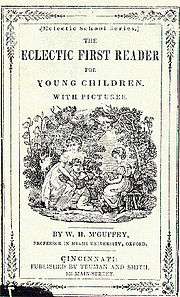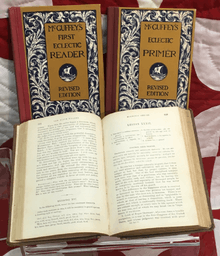McGuffey Readers
McGuffey Readers were a series of graded primers for grade levels 1-6. They were widely used as textbooks in American schools from the mid-19th century to the mid-20th century, and are still used today in some private schools and in homeschooling.

It is estimated that at least 120 million copies of McGuffey's Readers were sold between 1836 and 1960, placing its sales in a category with the Bible and Webster's Dictionary.[1] Since 1961, they have continued to sell at a rate of some 30,000 copies a year.[1] Only the Ray's Arithmetic series (1834-1913) matched it in popularity, written by a colleague of McGuffey's and begun in 1834.[1]
McGuffey
The editor of the Readers was William Holmes McGuffey. He was born September 23, 1800, near Claysville, Pennsylvania, and moved to Coitsville Township, Ohio, with his parents in 1802.[2] McGuffey's family had emigrated to America from Scotland in 1774, and they had strong opinions on religion and a belief in education. Consequently, education and preaching the Gospel were McGuffey's passions. He had a remarkable ability to memorize and could commit to memory entire books of the Bible.
McGuffey became a "roving" teacher at the age of 14, beginning with 48 students in a one-room school in Calcutta, Ohio, and at a seminary in the town of Poland, Ohio. The size of the class was just one of several challenges which the young McGuffey faced. In many one-teacher schools, students' ages varied from six to 21. McGuffey often worked 11 hours a day, six days a week, in a succession of frontier schools, primarily in the state of Kentucky. Students brought their own books, most frequently the Bible, since few textbooks existed.
Between teaching jobs, McGuffey received a classical education at the Greersburg Academy (also called The Old Stone Academy) in Darlington, Pennsylvania. He went on to study at Washington College (now Washington & Jefferson College) where he graduated in 1826. That same year, he was appointed to a position as Professor of Languages at Miami University in Oxford, Ohio.
McGuffey became famous as the author of the Readers (more accurately the editor), but he wrote few other works. He left Miami University for positions of successively greater responsibility at Cincinnati College, Ohio University in Athens, Ohio, and Woodward College in Cincinnati, where he served as president. He ended his career as a Professor of Moral Philosophy at the University of Virginia.
Publication
McGuffey established a reputation as a lecturer on moral and biblical subjects while he was teaching at Miami University. In 1835, the small Cincinnati publishing firm of Truman and Smith asked him to create a series of four graded readers for primary level students. He had been recommended for the job by longtime friend Harriet Beecher Stowe. He completed the first two readers within a year of signing his contract, receiving a fee of $1,000 ($20,000 in 2019 dollars). He compiled the first four readers (1836-1837 edition), while the fifth and sixth were created by his brother Alexander during the 1840s. The series consisted of stories, poems, essays, and speeches. The advanced Readers contained excerpts from the works of well-regarded English and American writers and politicians such as Lord Byron, John Milton, and Daniel Webster.
Most schools of the 19th century used only the first two in the series of McGuffey's four readers. The first Reader taught reading by using the phonics method, the identification of letters and their arrangement into words, and aided with slate work. The second Reader was used once students could read. It helped them to understand the meaning of sentences, while providing vivid stories which children could remember. The third Reader taught the definitions of words and was written at a level equivalent to the modern 5th or 6th grade. The fourth Reader was written for the highest levels of ability on the grammar school level.
McGuffey's Readers were among the first textbooks in the United States designed to be increasingly challenging with each volume. They used word repetition in the text as a learning tool, developing reading skills by challenging students using the books. Sounding-out, enunciation, and accents were emphasized. Colonial-era texts had offered dull lists of 20 to 100 new words per page for memorization. In contrast, McGuffey used new vocabulary words in the context of real literature, gradually introducing new words and carefully repeating the old.
McGuffey believed that teachers, as well as their students, should study the lessons and suggested that they read aloud to their classes. He also listed questions after each story, for he believed that asking questions was critical for a teacher to give instruction. The Readers emphasized spelling, vocabulary, and formal public speaking, which was a more common requirement in 19th-century America than today.
McGuffey is remembered as a conservative theological teacher. He interpreted the goals of public schooling in terms of moral and spiritual education, and attempted to give schools a curriculum that would instill Presbyterian Calvinist beliefs and manners in their students. These goals were considered suitable for the relatively homogeneous America of the early- to mid-19th century, though they were less so for the increasingly pluralistic society that developed in the late 19th century and early 20th century.
The content of the readers changed drastically between McGuffey's 1836-1837 edition and the 1879 edition. The revised Readers were compiled to meet the needs of national unity and the dream of an American melting pot for the world's oppressed masses. The Calvinist values of salvation, righteousness, and piety were excluded from the later versions, though they had been prominent in the early Readers. The content of the books was secularized and replaced by middle-class civil religion, morality, and values. McGuffey's name was featured on these revised editions, yet he neither contributed to them nor approved their content.
Other types of schoolbooks gradually replaced McGuffey's in the academic marketplace. The desire for distinct grade levels and less overtly religious content, and the greater profitability of consumable workbooks all helped to bring about their decline. McGuffey's Readers never entirely disappeared, however. Reprinted versions of his Readers are still in print, and may be purchased in bookstores across the country. Today, McGuffey's Readers are popular among homeschoolers and in some Protestant religious schools.[3]
Influence
Pulitzer Prize-winning writer Ron Powers notes that the Readers affected the first mass-educated and mass-literate generation in the modern world.

The manufacturer Henry Ford cited McGuffey's Readers as one of his most important childhood influences. He was an avid fan of McGuffey's Readers first editions, and claimed as an adult to be able to quote from McGuffey's by memory at great length. Ford republished all six Readers from the 1867 edition and distributed complete sets of them, at his own expense, to schools across the United States. In 1934, Ford had the log cabin where McGuffey was born moved to Greenfield Village, Ford's museum of Americana at Dearborn, Michigan. In 1936, Ford was an associate editor (along with Hamlin Garland, John W. Studebaker and William F. Wiley) of a collection of excerpts from McGuffey Readers. This 482-page compendium was dedicated to Ford, "lifelong devotee of his boyhood Alma Mater, the McGuffey Readers".
American composer Burrill Phillips composed a work entitled Selections from McGuffey's Reader, for orchestra, based on poems by Henry Wadsworth Longfellow and Oliver Wendell Holmes, Sr. It was completed in 1933.
In Popular Culture
In the 1965 western Nevada Smith, Steve McQueen's character Max Sand, who could not read, purchases a McGuffey reader from a supply store, and mention is made of it throughout the movie.
References
- The National Park Service and the United States Department of Interior. "William Holmes McGuffey and His Readers" (PDF). The Museum Gazette.CS1 maint: uses authors parameter (link)
- "National Register of Historic Places - Boyhood Home of William Holmes McGuffey".
- Smith, S.J. (2008). "McGuffey Readers". Liberty University. Retrieved October 29, 2011.
Bibliography
- Best, John Hardin (February 2000). "McGuffey, William Holmes". American National Biography Online.
- Mosier, Richard D. (1947). Making the American Mind: Social and Moral Ideas in the McGuffey Readers.
- Westerhoff III, John H. (1978). McGuffey and His Readers: Piety, Morality, and Education in Nineteenth-Century America.
External links
- Inscription in a copy of McGuffey's Fifth Eclectic Reader
- McGuffy Reader Collection From the Rare Book and Special Collections Division at the Library of Congress
- Project Gutenberg downloads of Eclectic First Reader (Revised)
- "The Memory of McGuffey"
- William Holmes McGuffey Museum and National Historic Landmark at Miami University, Oxford, OH